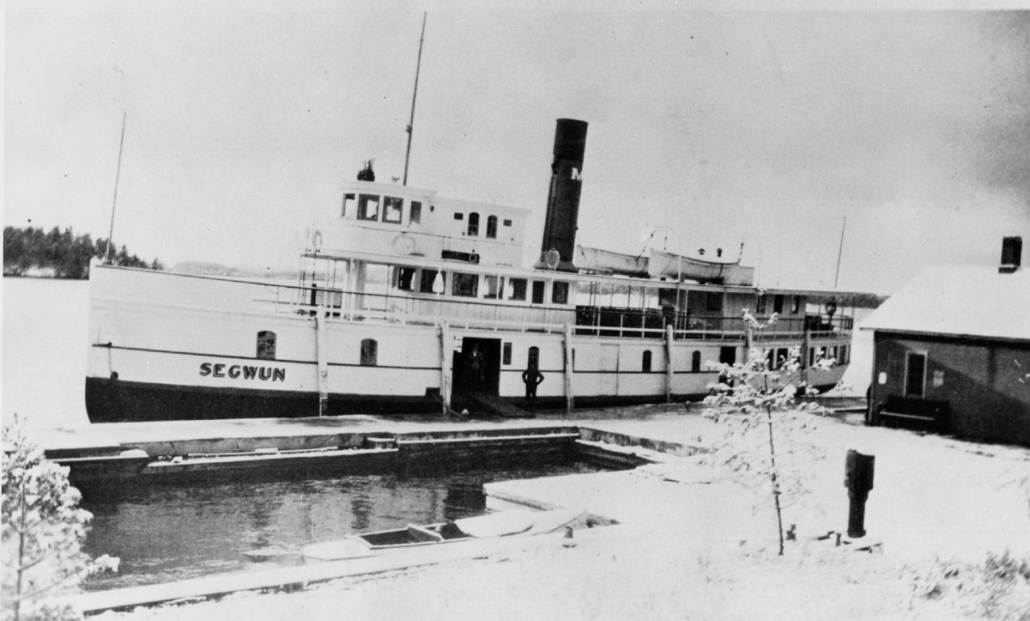
I cannot remember my first trip on the R.M.S. Segwun, so I presume it must have been ordinary. I do, however, remember one trip which was extraordinary. It was unscheduled, short, and without benefit of steam power.
Sometime after the steamships stopped running in 1958, the company assets were sold to George Morrison and Jack Vincent. They gave the Segwun to the town for a nominal one dollar, to be used as a museum.
Peter Stewart was the first Chairman of the Museum Board. My wife, Marion, became chairperson somewhere in the mid-sixties, and she spent a great deal of time preparing and displaying the exhibits, cleaning up and reorganizing the interior of the vessel.
Early each winter, when the ice on the lake was thick enough to be safe, Arne Nielson, another member of the Museum Board, would bring his chainsaw, and cut a line through the ice about six feet away from the boat’s outer side. He then sawed the intervening ice into large cakes, and with poles, we pushed them down under the solid ice.
This created a narrow pond, and allowed the boat to be pried away and pushed away from the dock. Temporary anchors held it to the solid ice so it could freeze in for the winter, away from contact with the dock. As water levels dropped in late winter or spring, there was less risk that the boat would list severely and be damaged because one side was tight to the dock.
In spring, of course, the ice would melt, and the boat would have to be snugged up again.
In the spring of 1968, as the bay ice was becoming rotten, Marion was making frequent trips down to see if Segwun could be pulled in yet.
One night, there was a strong wind. She and I went down and found the Segwun already free, straining at the heavy chains which held her.
Our puny pull on the chains did nothing, so Marion went to get the keys which would allow us aboard for rope. She was scarcely out of sight when the front chain snapped with an impressive bang.
Doug Barnes, who lived nearby, saw the problem and started putting his boat in. Marion arrived back just in time to hear the second loud report as the back chain parted.
Now Segwun was an uncontrolled sail boat. She skittered off like a mare heading for the barn. I thought one of the homes beyond Lookout Park was about to be surprised by a new lawn ornament, but nature intervened. The ice wasn’t quite ready to disintegrate, and the boat became stuck in the slush pack.
Doug Barnes piloted me, keys in hand, while Marion went for help.
The padlock on the outer door didn’t recognize the key, so there was another trip back to the dock for a hammer. The lock saw reason after a few blows.
The capstan on Segwun was operable, so Doug took the loop end of one of the big ropes by boat to the dock and put it over a bollard. I wrapped the free end and started to lever the capstan. Unfortunately, I had the rope wrapped in the wrong direction. By the time that was remedied, Doug was back aboard and we were beginning to have some success in moving the boat shorewards.
There were further developments by now. The fire department had arrived, and with them, Cal Waite’s wrecker. Doug brought its cable and attached the hook to the boat. Soon Cal was hauling that end as the front approached the dock by rope power.
We were almost close enough to finish the job when the back cable broke, and Segwun was off again on its second voyage of the season, as an apprentice icebreaker. Worse, the rope at the front became snarled around a big cleat, and was chopped free.
Alvin Saulter, the former engineer of the Navigation Company, and the curator of the Segwun Steamboat Museum, had arrived by now, to give me some training in winch operation and general seamanship. He said, “Well, we’ll have lots of ropes on the ship now,” as he gazed at the harvest of one foot lengths.
The second time, Cal’s cable held, and Segwun, with all the help, were soon tamed.
The title of the book about the Titanic was A Night to Remember. Luckily, my night to remember Segwun ended more cheerfully, thanks to all those guys who responded so quickly to our Muskoka Marine Disaster.
By Cyril Fry





